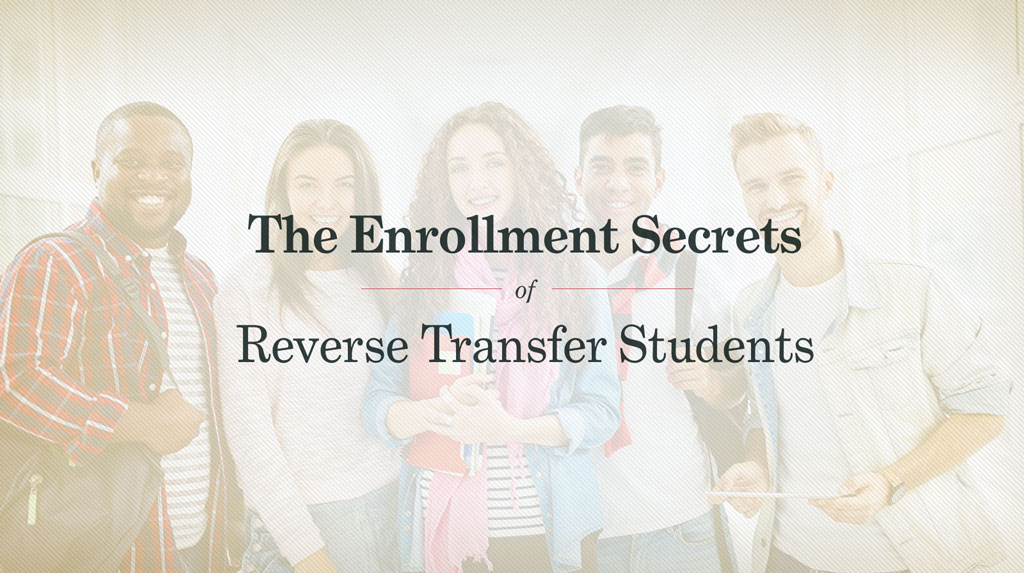Why students leave four-year institutions to enroll at community college
Of all the groups of students who enroll in community colleges every year, reverse transfer students are especially interesting. Community colleges are a common destination for students leaving four-year institutions, according to National Student Clearinghouse Research Center data. These students are choosing to do a ‘reverse transfer’ for a number of different reasons, and the outcomes vary tremendously.
Community colleges have been focusing on transfer students whose college pathways proceed from two-year to four-year institutions. However, 19.8% of all enrollees from the class of 2005 who transferred or enrolled elsewhere within five years of beginning their degrees at four-year institutions came to community colleges (Shapiro & Dundar). That’s 246,078 students. It’s important that enrollment managers understand this relatively large demographic.
The Superchargers
About twenty-five percent of the students who returned to community colleges from four-year institutions came back for summer courses. In their recent paper on reverse transfer students, Doug Shapiro and Afet Dundar call these students “superchargers.” They come back to power up between semesters at four-year institutions, planning to transfer back credits earned during summer break.
Superchargers are likely local high school graduates, or nontraditional students attending a local college. The vast majority, eighty percent, of superchargers will return to their original four-year institution. These students also often have better overall outcomes than their peers. Within six years, they were roughly twenty percent more likely to graduate than students who didn’t take any extra courses at community colleges.
The Rechargers
Shapiro and Dundar identified another group of students who returned to community colleges as ‘rechargers.’ These students transferred back to a community college for a regular term. These students struggled at their first school and use the time at a community college to recharge. They haven’t given up on education, but they may need to spend time developing study skills, taking remedial coursework, or rethinking their academic goals.
These students often discovered that their initial college or course of study was a poor fit. Although about 45% of these students will return to a four-year institution, only 17% returned to their institution of origin. Community colleges provide safe and supportive educational environments that allow them to evaluate what educational pathways will be a better fit.
The Rebooters
Finally, Shapiro and Dundar talk about the ‘rebooters.’ These students were the bare majority of those who left their four-year starting institutions during a regular term, at 55%. Unfortunately, many of these students experienced a dramatic setback at their school of choice. It’s especially important to identify these students, because without proper support, they are likely to leave community college as well, and never complete their education.
Strategic enrollment managers should watch out for rebooters, and perhaps initiate programs to help them succeed on their new college pathway. Community colleges have an ill-deserved reputation for easy A’s. Academically unprepared students are sometimes surprised to find they struggle at two-year institutions as well. Still, with the right support, they could flourish and increase an institution’s number of degree awards substantially.
What does this all mean for strategic enrollment managers?
So roughly a quarter of reverse transfer students were superchargers, and the remaining three-quarters were rechargers or rebooters. Although clearly the rebooters should cause enrollment managers most concern in terms of completion, they shouldn’t dominate the narrative. Enrollment managers can support and attract all types of reverse transfer students.
- Promote summer courses to highly motivated superchargers. It may also be helpful to collect data on these students and their educational outcomes so that the important contributions community colleges make to their success aren’t forgotten.
- Address the needs of rechargers who may have found that their first choice of school was a poor fit for any number of reasons. These students might need academic support, but they certainly need involved advisors who can help them choose a better college pathway.
- Immediately identify rebooters, and offer additional advising and academic support, or possibly reroute them into remedial classes. While these students may still have suboptimal outcomes, intervening proactively gives them the greatest possible chance of success.
If the numbers on reverse transfer students stay the same over the next decade, they will certainly remain an important student demographic. At least for now, they have made community colleges their home. When they succeed, so do our institutions.
References
Shapiro, D., & Dundar, A., “New Context for Retention and Persistence.” ed. Don Hossler and Bob Bontrager. Handbook of Strategic Enrollment Management. vol. first edition, San Francisco, CA: Jossey-Bass, 249-276


